Legal and Professional Issues in Nursing: Clinical Placement Report
VerifiedAdded on 2022/11/13
|12
|4089
|229
Report
AI Summary
This report examines legal and professional issues encountered by student nurses during clinical placements, focusing on the application of legal and ethical frameworks, professional codes, and guidelines. The assignment addresses the scope of practice for student nurses, appropriate nursing care in the first and last weeks of clinical placements, and the negotiation of care delegation with registered nurses, referencing the NMBA framework. The report includes a detailed analysis of an ethical dilemma involving taking selfies with patients, considering the implications of the Data Protection Act, HIPAA, and the NMBA code of conduct. It emphasizes the importance of practical experience under the guidance of registered nurses for student nurses. The report provides justifications for appropriate nursing care practices, emphasizing the importance of a student nurse's skill level and adherence to guidelines. The findings highlight the significance of social learning theory and role modeling for skill development and the need for clear communication and negotiation in delegation practices. The report concludes with a summary of the key findings and their implications for nursing practice.
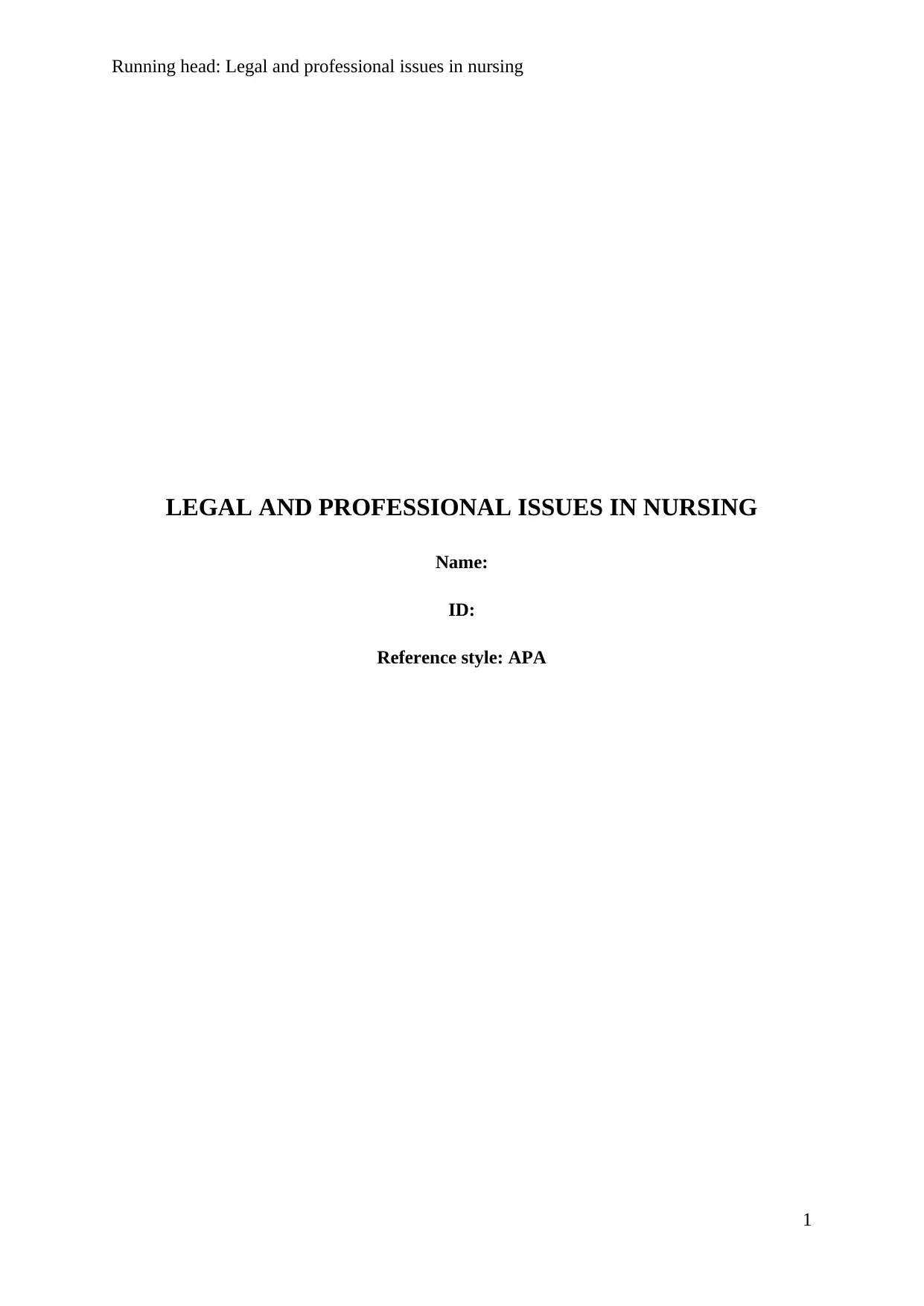
Running head: Legal and professional issues in nursing
LEGAL AND PROFESSIONAL ISSUES IN NURSING
Name:
ID:
Reference style: APA
1
LEGAL AND PROFESSIONAL ISSUES IN NURSING
Name:
ID:
Reference style: APA
1
Paraphrase This Document
Need a fresh take? Get an instant paraphrase of this document with our AI Paraphraser
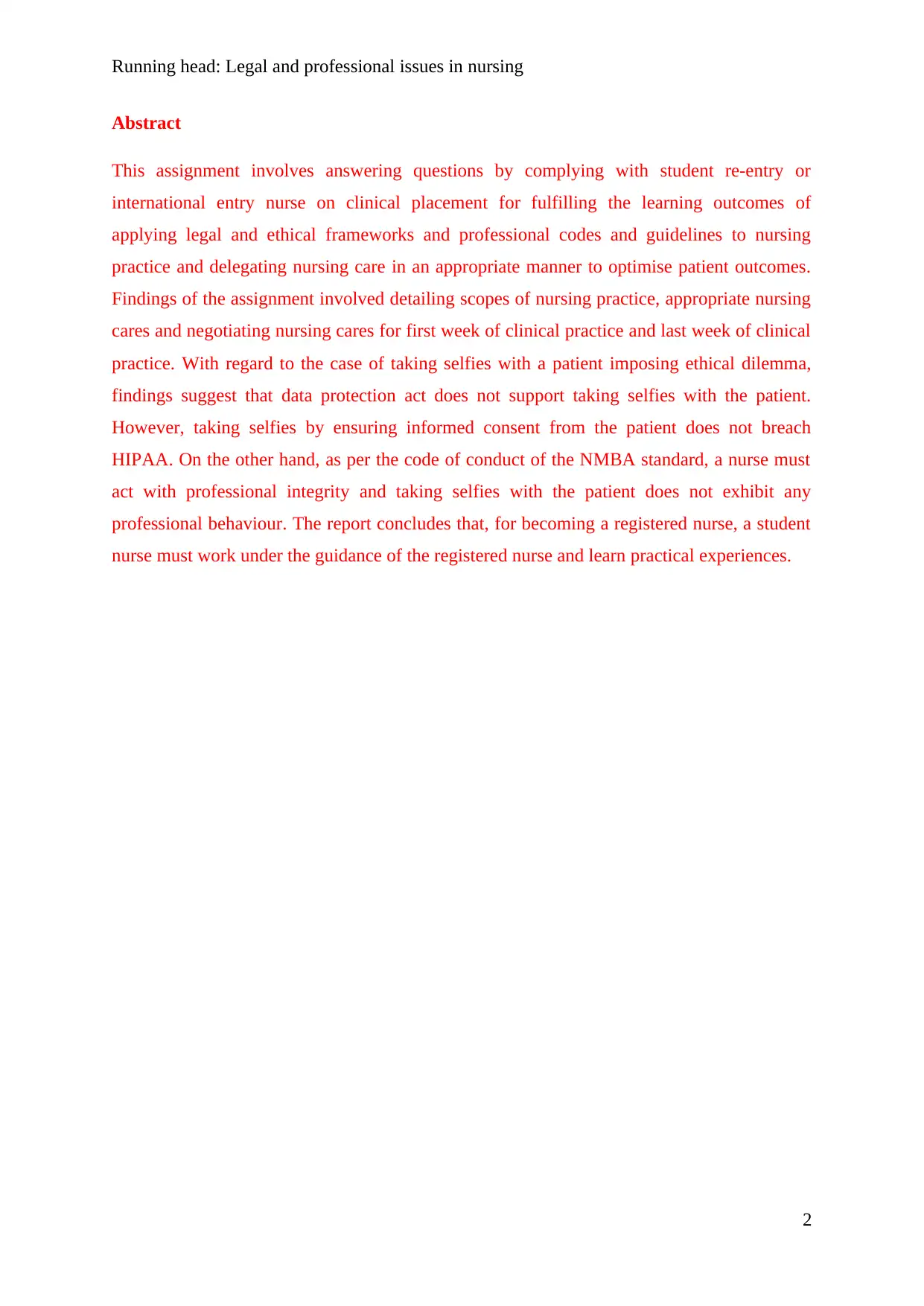
Running head: Legal and professional issues in nursing
Abstract
This assignment involves answering questions by complying with student re-entry or
international entry nurse on clinical placement for fulfilling the learning outcomes of
applying legal and ethical frameworks and professional codes and guidelines to nursing
practice and delegating nursing care in an appropriate manner to optimise patient outcomes.
Findings of the assignment involved detailing scopes of nursing practice, appropriate nursing
cares and negotiating nursing cares for first week of clinical practice and last week of clinical
practice. With regard to the case of taking selfies with a patient imposing ethical dilemma,
findings suggest that data protection act does not support taking selfies with the patient.
However, taking selfies by ensuring informed consent from the patient does not breach
HIPAA. On the other hand, as per the code of conduct of the NMBA standard, a nurse must
act with professional integrity and taking selfies with the patient does not exhibit any
professional behaviour. The report concludes that, for becoming a registered nurse, a student
nurse must work under the guidance of the registered nurse and learn practical experiences.
2
Abstract
This assignment involves answering questions by complying with student re-entry or
international entry nurse on clinical placement for fulfilling the learning outcomes of
applying legal and ethical frameworks and professional codes and guidelines to nursing
practice and delegating nursing care in an appropriate manner to optimise patient outcomes.
Findings of the assignment involved detailing scopes of nursing practice, appropriate nursing
cares and negotiating nursing cares for first week of clinical practice and last week of clinical
practice. With regard to the case of taking selfies with a patient imposing ethical dilemma,
findings suggest that data protection act does not support taking selfies with the patient.
However, taking selfies by ensuring informed consent from the patient does not breach
HIPAA. On the other hand, as per the code of conduct of the NMBA standard, a nurse must
act with professional integrity and taking selfies with the patient does not exhibit any
professional behaviour. The report concludes that, for becoming a registered nurse, a student
nurse must work under the guidance of the registered nurse and learn practical experiences.
2
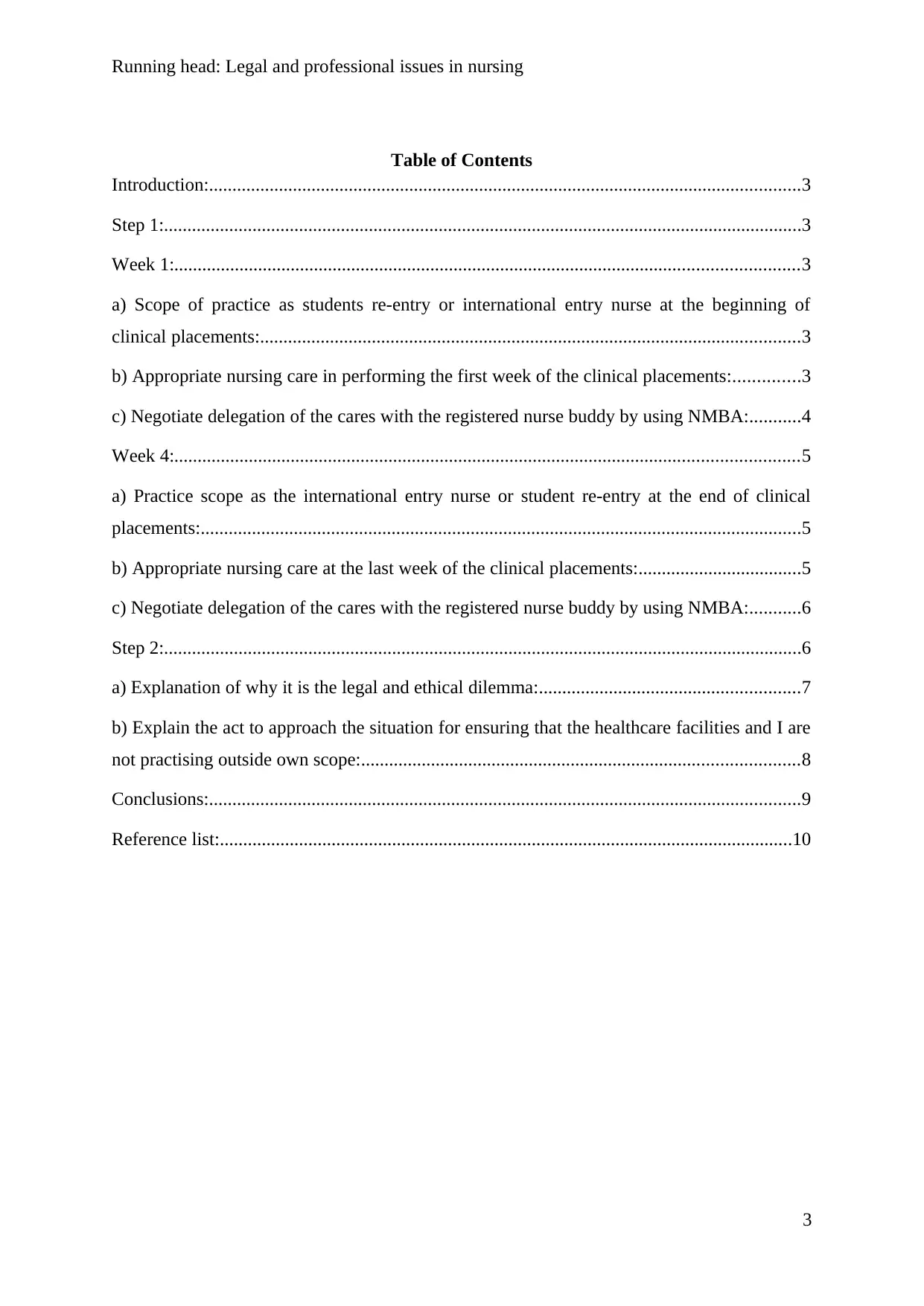
Running head: Legal and professional issues in nursing
Table of Contents
Introduction:...............................................................................................................................3
Step 1:.........................................................................................................................................3
Week 1:......................................................................................................................................3
a) Scope of practice as students re-entry or international entry nurse at the beginning of
clinical placements:....................................................................................................................3
b) Appropriate nursing care in performing the first week of the clinical placements:..............3
c) Negotiate delegation of the cares with the registered nurse buddy by using NMBA:...........4
Week 4:......................................................................................................................................5
a) Practice scope as the international entry nurse or student re-entry at the end of clinical
placements:.................................................................................................................................5
b) Appropriate nursing care at the last week of the clinical placements:...................................5
c) Negotiate delegation of the cares with the registered nurse buddy by using NMBA:...........6
Step 2:.........................................................................................................................................6
a) Explanation of why it is the legal and ethical dilemma:........................................................7
b) Explain the act to approach the situation for ensuring that the healthcare facilities and I are
not practising outside own scope:..............................................................................................8
Conclusions:...............................................................................................................................9
Reference list:...........................................................................................................................10
3
Table of Contents
Introduction:...............................................................................................................................3
Step 1:.........................................................................................................................................3
Week 1:......................................................................................................................................3
a) Scope of practice as students re-entry or international entry nurse at the beginning of
clinical placements:....................................................................................................................3
b) Appropriate nursing care in performing the first week of the clinical placements:..............3
c) Negotiate delegation of the cares with the registered nurse buddy by using NMBA:...........4
Week 4:......................................................................................................................................5
a) Practice scope as the international entry nurse or student re-entry at the end of clinical
placements:.................................................................................................................................5
b) Appropriate nursing care at the last week of the clinical placements:...................................5
c) Negotiate delegation of the cares with the registered nurse buddy by using NMBA:...........6
Step 2:.........................................................................................................................................6
a) Explanation of why it is the legal and ethical dilemma:........................................................7
b) Explain the act to approach the situation for ensuring that the healthcare facilities and I are
not practising outside own scope:..............................................................................................8
Conclusions:...............................................................................................................................9
Reference list:...........................................................................................................................10
3
⊘ This is a preview!⊘
Do you want full access?
Subscribe today to unlock all pages.

Trusted by 1+ million students worldwide
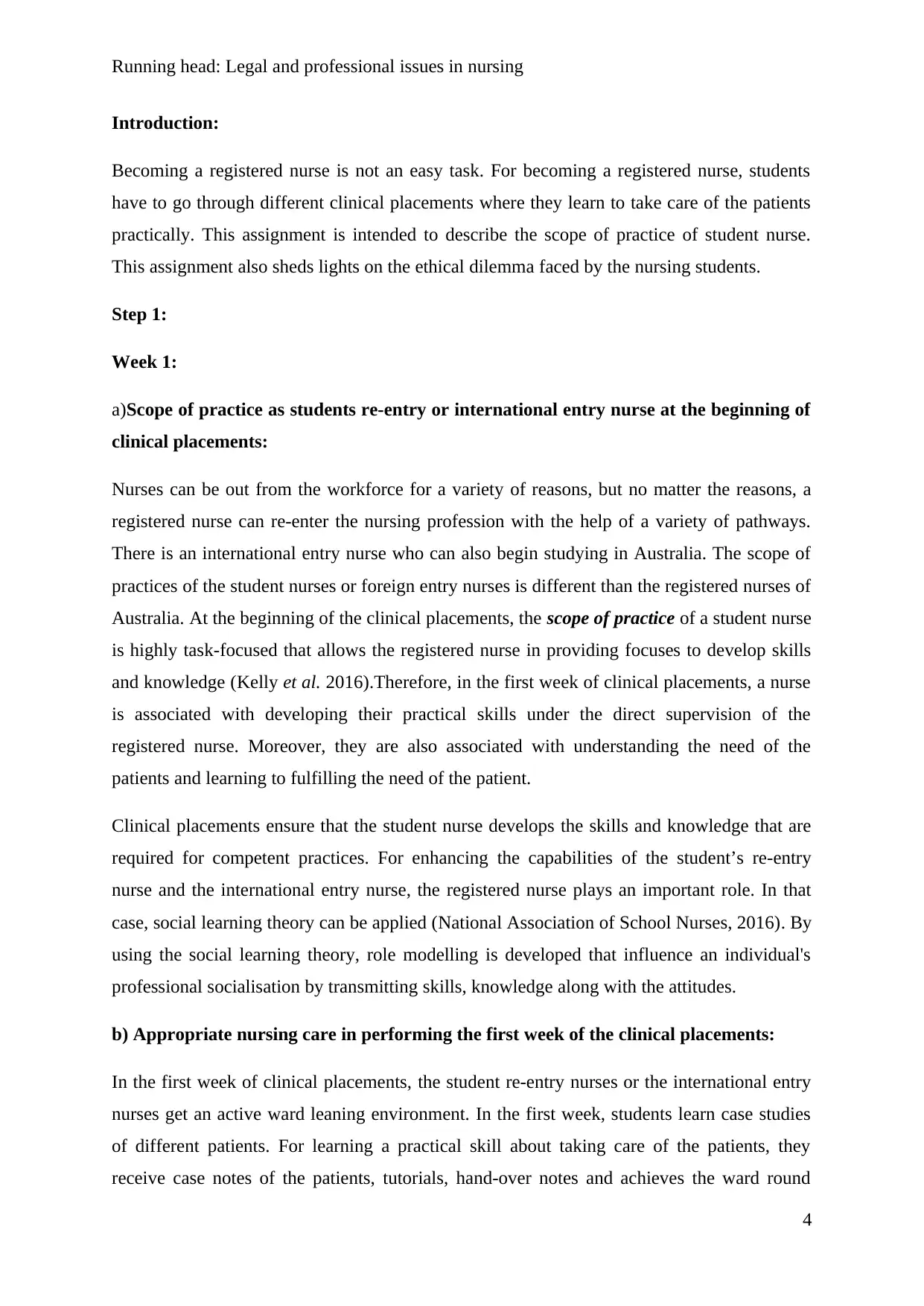
Running head: Legal and professional issues in nursing
Introduction:
Becoming a registered nurse is not an easy task. For becoming a registered nurse, students
have to go through different clinical placements where they learn to take care of the patients
practically. This assignment is intended to describe the scope of practice of student nurse.
This assignment also sheds lights on the ethical dilemma faced by the nursing students.
Step 1:
Week 1:
a)Scope of practice as students re-entry or international entry nurse at the beginning of
clinical placements:
Nurses can be out from the workforce for a variety of reasons, but no matter the reasons, a
registered nurse can re-enter the nursing profession with the help of a variety of pathways.
There is an international entry nurse who can also begin studying in Australia. The scope of
practices of the student nurses or foreign entry nurses is different than the registered nurses of
Australia. At the beginning of the clinical placements, the scope of practice of a student nurse
is highly task-focused that allows the registered nurse in providing focuses to develop skills
and knowledge (Kelly et al. 2016).Therefore, in the first week of clinical placements, a nurse
is associated with developing their practical skills under the direct supervision of the
registered nurse. Moreover, they are also associated with understanding the need of the
patients and learning to fulfilling the need of the patient.
Clinical placements ensure that the student nurse develops the skills and knowledge that are
required for competent practices. For enhancing the capabilities of the student’s re-entry
nurse and the international entry nurse, the registered nurse plays an important role. In that
case, social learning theory can be applied (National Association of School Nurses, 2016). By
using the social learning theory, role modelling is developed that influence an individual's
professional socialisation by transmitting skills, knowledge along with the attitudes.
b) Appropriate nursing care in performing the first week of the clinical placements:
In the first week of clinical placements, the student re-entry nurses or the international entry
nurses get an active ward leaning environment. In the first week, students learn case studies
of different patients. For learning a practical skill about taking care of the patients, they
receive case notes of the patients, tutorials, hand-over notes and achieves the ward round
4
Introduction:
Becoming a registered nurse is not an easy task. For becoming a registered nurse, students
have to go through different clinical placements where they learn to take care of the patients
practically. This assignment is intended to describe the scope of practice of student nurse.
This assignment also sheds lights on the ethical dilemma faced by the nursing students.
Step 1:
Week 1:
a)Scope of practice as students re-entry or international entry nurse at the beginning of
clinical placements:
Nurses can be out from the workforce for a variety of reasons, but no matter the reasons, a
registered nurse can re-enter the nursing profession with the help of a variety of pathways.
There is an international entry nurse who can also begin studying in Australia. The scope of
practices of the student nurses or foreign entry nurses is different than the registered nurses of
Australia. At the beginning of the clinical placements, the scope of practice of a student nurse
is highly task-focused that allows the registered nurse in providing focuses to develop skills
and knowledge (Kelly et al. 2016).Therefore, in the first week of clinical placements, a nurse
is associated with developing their practical skills under the direct supervision of the
registered nurse. Moreover, they are also associated with understanding the need of the
patients and learning to fulfilling the need of the patient.
Clinical placements ensure that the student nurse develops the skills and knowledge that are
required for competent practices. For enhancing the capabilities of the student’s re-entry
nurse and the international entry nurse, the registered nurse plays an important role. In that
case, social learning theory can be applied (National Association of School Nurses, 2016). By
using the social learning theory, role modelling is developed that influence an individual's
professional socialisation by transmitting skills, knowledge along with the attitudes.
b) Appropriate nursing care in performing the first week of the clinical placements:
In the first week of clinical placements, the student re-entry nurses or the international entry
nurses get an active ward leaning environment. In the first week, students learn case studies
of different patients. For learning a practical skill about taking care of the patients, they
receive case notes of the patients, tutorials, hand-over notes and achieves the ward round
4
Paraphrase This Document
Need a fresh take? Get an instant paraphrase of this document with our AI Paraphraser
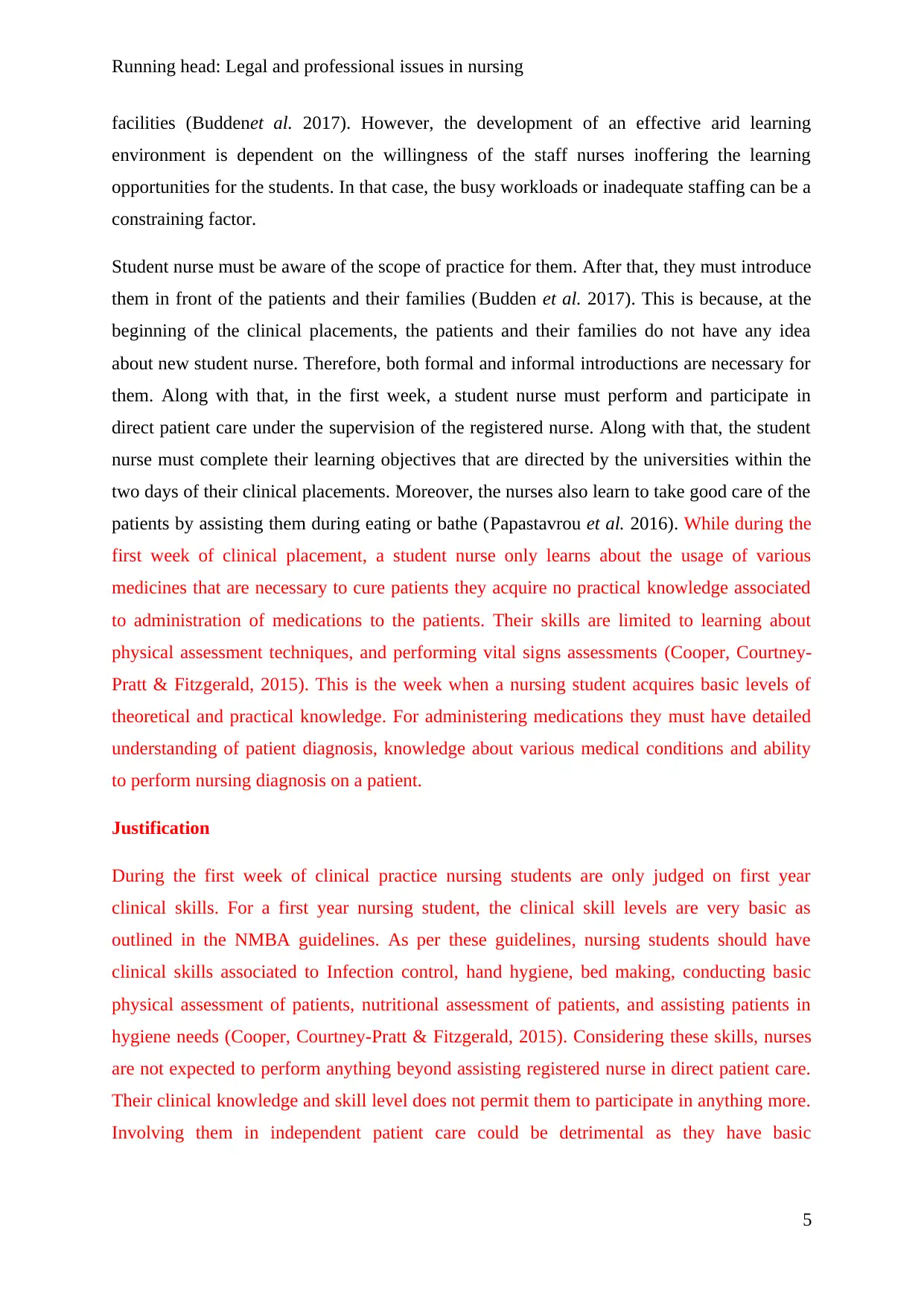
Running head: Legal and professional issues in nursing
facilities (Buddenet al. 2017). However, the development of an effective arid learning
environment is dependent on the willingness of the staff nurses inoffering the learning
opportunities for the students. In that case, the busy workloads or inadequate staffing can be a
constraining factor.
Student nurse must be aware of the scope of practice for them. After that, they must introduce
them in front of the patients and their families (Budden et al. 2017). This is because, at the
beginning of the clinical placements, the patients and their families do not have any idea
about new student nurse. Therefore, both formal and informal introductions are necessary for
them. Along with that, in the first week, a student nurse must perform and participate in
direct patient care under the supervision of the registered nurse. Along with that, the student
nurse must complete their learning objectives that are directed by the universities within the
two days of their clinical placements. Moreover, the nurses also learn to take good care of the
patients by assisting them during eating or bathe (Papastavrou et al. 2016). While during the
first week of clinical placement, a student nurse only learns about the usage of various
medicines that are necessary to cure patients they acquire no practical knowledge associated
to administration of medications to the patients. Their skills are limited to learning about
physical assessment techniques, and performing vital signs assessments (Cooper, Courtney-
Pratt & Fitzgerald, 2015). This is the week when a nursing student acquires basic levels of
theoretical and practical knowledge. For administering medications they must have detailed
understanding of patient diagnosis, knowledge about various medical conditions and ability
to perform nursing diagnosis on a patient.
Justification
During the first week of clinical practice nursing students are only judged on first year
clinical skills. For a first year nursing student, the clinical skill levels are very basic as
outlined in the NMBA guidelines. As per these guidelines, nursing students should have
clinical skills associated to Infection control, hand hygiene, bed making, conducting basic
physical assessment of patients, nutritional assessment of patients, and assisting patients in
hygiene needs (Cooper, Courtney-Pratt & Fitzgerald, 2015). Considering these skills, nurses
are not expected to perform anything beyond assisting registered nurse in direct patient care.
Their clinical knowledge and skill level does not permit them to participate in anything more.
Involving them in independent patient care could be detrimental as they have basic
5
facilities (Buddenet al. 2017). However, the development of an effective arid learning
environment is dependent on the willingness of the staff nurses inoffering the learning
opportunities for the students. In that case, the busy workloads or inadequate staffing can be a
constraining factor.
Student nurse must be aware of the scope of practice for them. After that, they must introduce
them in front of the patients and their families (Budden et al. 2017). This is because, at the
beginning of the clinical placements, the patients and their families do not have any idea
about new student nurse. Therefore, both formal and informal introductions are necessary for
them. Along with that, in the first week, a student nurse must perform and participate in
direct patient care under the supervision of the registered nurse. Along with that, the student
nurse must complete their learning objectives that are directed by the universities within the
two days of their clinical placements. Moreover, the nurses also learn to take good care of the
patients by assisting them during eating or bathe (Papastavrou et al. 2016). While during the
first week of clinical placement, a student nurse only learns about the usage of various
medicines that are necessary to cure patients they acquire no practical knowledge associated
to administration of medications to the patients. Their skills are limited to learning about
physical assessment techniques, and performing vital signs assessments (Cooper, Courtney-
Pratt & Fitzgerald, 2015). This is the week when a nursing student acquires basic levels of
theoretical and practical knowledge. For administering medications they must have detailed
understanding of patient diagnosis, knowledge about various medical conditions and ability
to perform nursing diagnosis on a patient.
Justification
During the first week of clinical practice nursing students are only judged on first year
clinical skills. For a first year nursing student, the clinical skill levels are very basic as
outlined in the NMBA guidelines. As per these guidelines, nursing students should have
clinical skills associated to Infection control, hand hygiene, bed making, conducting basic
physical assessment of patients, nutritional assessment of patients, and assisting patients in
hygiene needs (Cooper, Courtney-Pratt & Fitzgerald, 2015). Considering these skills, nurses
are not expected to perform anything beyond assisting registered nurse in direct patient care.
Their clinical knowledge and skill level does not permit them to participate in anything more.
Involving them in independent patient care could be detrimental as they have basic
5
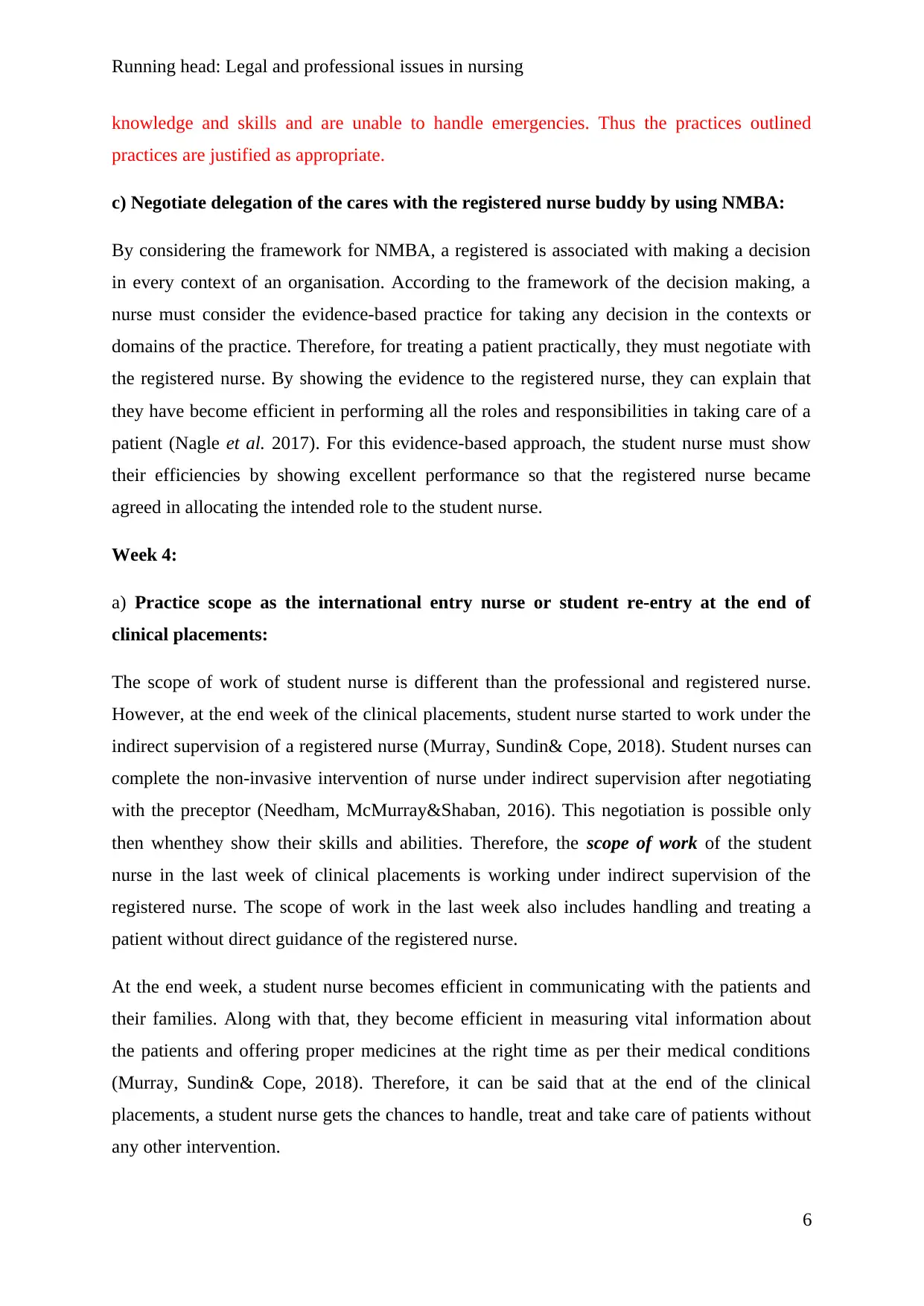
Running head: Legal and professional issues in nursing
knowledge and skills and are unable to handle emergencies. Thus the practices outlined
practices are justified as appropriate.
c) Negotiate delegation of the cares with the registered nurse buddy by using NMBA:
By considering the framework for NMBA, a registered is associated with making a decision
in every context of an organisation. According to the framework of the decision making, a
nurse must consider the evidence-based practice for taking any decision in the contexts or
domains of the practice. Therefore, for treating a patient practically, they must negotiate with
the registered nurse. By showing the evidence to the registered nurse, they can explain that
they have become efficient in performing all the roles and responsibilities in taking care of a
patient (Nagle et al. 2017). For this evidence-based approach, the student nurse must show
their efficiencies by showing excellent performance so that the registered nurse became
agreed in allocating the intended role to the student nurse.
Week 4:
a) Practice scope as the international entry nurse or student re-entry at the end of
clinical placements:
The scope of work of student nurse is different than the professional and registered nurse.
However, at the end week of the clinical placements, student nurse started to work under the
indirect supervision of a registered nurse (Murray, Sundin& Cope, 2018). Student nurses can
complete the non-invasive intervention of nurse under indirect supervision after negotiating
with the preceptor (Needham, McMurray&Shaban, 2016). This negotiation is possible only
then whenthey show their skills and abilities. Therefore, the scope of work of the student
nurse in the last week of clinical placements is working under indirect supervision of the
registered nurse. The scope of work in the last week also includes handling and treating a
patient without direct guidance of the registered nurse.
At the end week, a student nurse becomes efficient in communicating with the patients and
their families. Along with that, they become efficient in measuring vital information about
the patients and offering proper medicines at the right time as per their medical conditions
(Murray, Sundin& Cope, 2018). Therefore, it can be said that at the end of the clinical
placements, a student nurse gets the chances to handle, treat and take care of patients without
any other intervention.
6
knowledge and skills and are unable to handle emergencies. Thus the practices outlined
practices are justified as appropriate.
c) Negotiate delegation of the cares with the registered nurse buddy by using NMBA:
By considering the framework for NMBA, a registered is associated with making a decision
in every context of an organisation. According to the framework of the decision making, a
nurse must consider the evidence-based practice for taking any decision in the contexts or
domains of the practice. Therefore, for treating a patient practically, they must negotiate with
the registered nurse. By showing the evidence to the registered nurse, they can explain that
they have become efficient in performing all the roles and responsibilities in taking care of a
patient (Nagle et al. 2017). For this evidence-based approach, the student nurse must show
their efficiencies by showing excellent performance so that the registered nurse became
agreed in allocating the intended role to the student nurse.
Week 4:
a) Practice scope as the international entry nurse or student re-entry at the end of
clinical placements:
The scope of work of student nurse is different than the professional and registered nurse.
However, at the end week of the clinical placements, student nurse started to work under the
indirect supervision of a registered nurse (Murray, Sundin& Cope, 2018). Student nurses can
complete the non-invasive intervention of nurse under indirect supervision after negotiating
with the preceptor (Needham, McMurray&Shaban, 2016). This negotiation is possible only
then whenthey show their skills and abilities. Therefore, the scope of work of the student
nurse in the last week of clinical placements is working under indirect supervision of the
registered nurse. The scope of work in the last week also includes handling and treating a
patient without direct guidance of the registered nurse.
At the end week, a student nurse becomes efficient in communicating with the patients and
their families. Along with that, they become efficient in measuring vital information about
the patients and offering proper medicines at the right time as per their medical conditions
(Murray, Sundin& Cope, 2018). Therefore, it can be said that at the end of the clinical
placements, a student nurse gets the chances to handle, treat and take care of patients without
any other intervention.
6
⊘ This is a preview!⊘
Do you want full access?
Subscribe today to unlock all pages.

Trusted by 1+ million students worldwide
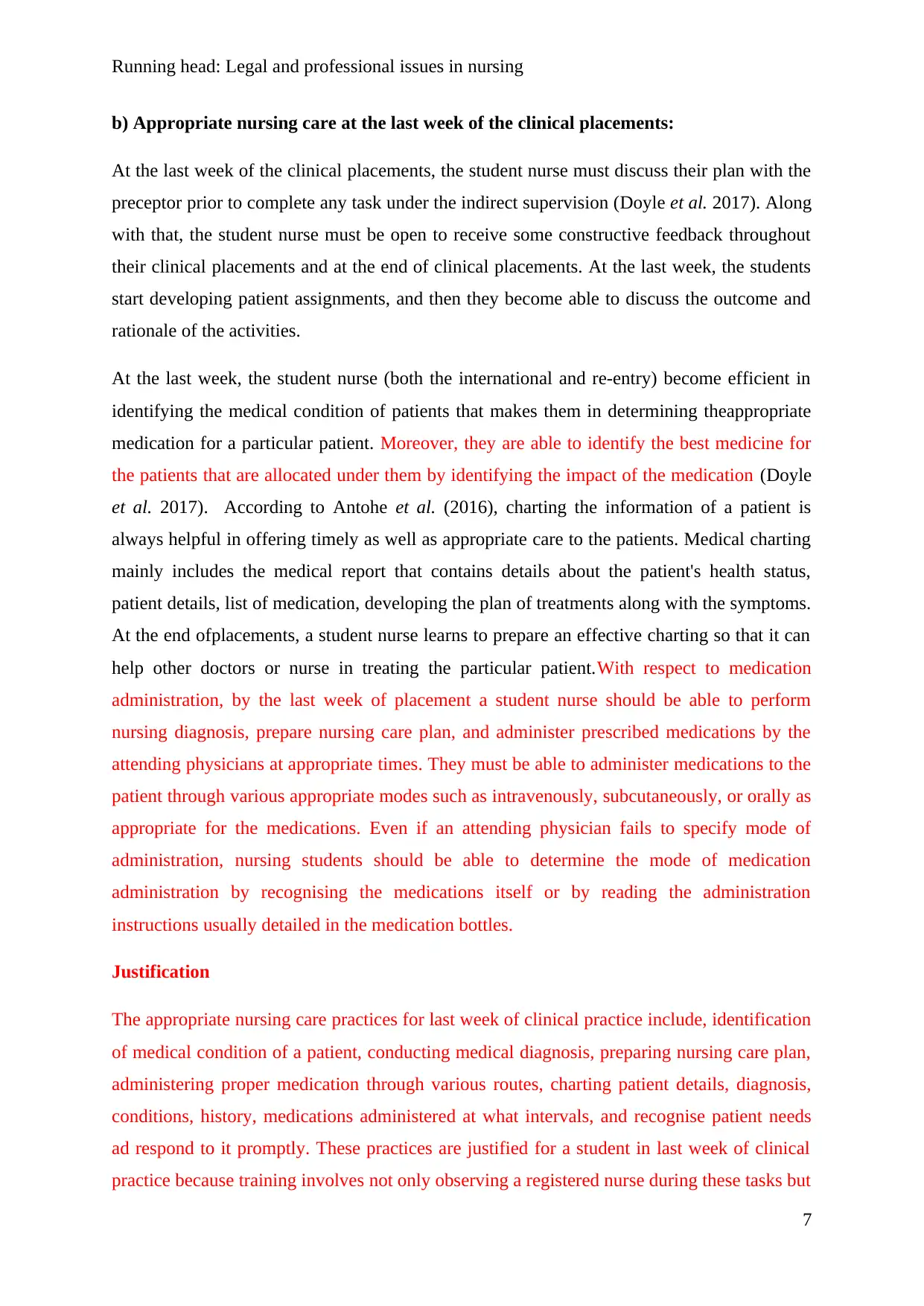
Running head: Legal and professional issues in nursing
b) Appropriate nursing care at the last week of the clinical placements:
At the last week of the clinical placements, the student nurse must discuss their plan with the
preceptor prior to complete any task under the indirect supervision (Doyle et al. 2017). Along
with that, the student nurse must be open to receive some constructive feedback throughout
their clinical placements and at the end of clinical placements. At the last week, the students
start developing patient assignments, and then they become able to discuss the outcome and
rationale of the activities.
At the last week, the student nurse (both the international and re-entry) become efficient in
identifying the medical condition of patients that makes them in determining theappropriate
medication for a particular patient. Moreover, they are able to identify the best medicine for
the patients that are allocated under them by identifying the impact of the medication (Doyle
et al. 2017). According to Antohe et al. (2016), charting the information of a patient is
always helpful in offering timely as well as appropriate care to the patients. Medical charting
mainly includes the medical report that contains details about the patient's health status,
patient details, list of medication, developing the plan of treatments along with the symptoms.
At the end ofplacements, a student nurse learns to prepare an effective charting so that it can
help other doctors or nurse in treating the particular patient.With respect to medication
administration, by the last week of placement a student nurse should be able to perform
nursing diagnosis, prepare nursing care plan, and administer prescribed medications by the
attending physicians at appropriate times. They must be able to administer medications to the
patient through various appropriate modes such as intravenously, subcutaneously, or orally as
appropriate for the medications. Even if an attending physician fails to specify mode of
administration, nursing students should be able to determine the mode of medication
administration by recognising the medications itself or by reading the administration
instructions usually detailed in the medication bottles.
Justification
The appropriate nursing care practices for last week of clinical practice include, identification
of medical condition of a patient, conducting medical diagnosis, preparing nursing care plan,
administering proper medication through various routes, charting patient details, diagnosis,
conditions, history, medications administered at what intervals, and recognise patient needs
ad respond to it promptly. These practices are justified for a student in last week of clinical
practice because training involves not only observing a registered nurse during these tasks but
7
b) Appropriate nursing care at the last week of the clinical placements:
At the last week of the clinical placements, the student nurse must discuss their plan with the
preceptor prior to complete any task under the indirect supervision (Doyle et al. 2017). Along
with that, the student nurse must be open to receive some constructive feedback throughout
their clinical placements and at the end of clinical placements. At the last week, the students
start developing patient assignments, and then they become able to discuss the outcome and
rationale of the activities.
At the last week, the student nurse (both the international and re-entry) become efficient in
identifying the medical condition of patients that makes them in determining theappropriate
medication for a particular patient. Moreover, they are able to identify the best medicine for
the patients that are allocated under them by identifying the impact of the medication (Doyle
et al. 2017). According to Antohe et al. (2016), charting the information of a patient is
always helpful in offering timely as well as appropriate care to the patients. Medical charting
mainly includes the medical report that contains details about the patient's health status,
patient details, list of medication, developing the plan of treatments along with the symptoms.
At the end ofplacements, a student nurse learns to prepare an effective charting so that it can
help other doctors or nurse in treating the particular patient.With respect to medication
administration, by the last week of placement a student nurse should be able to perform
nursing diagnosis, prepare nursing care plan, and administer prescribed medications by the
attending physicians at appropriate times. They must be able to administer medications to the
patient through various appropriate modes such as intravenously, subcutaneously, or orally as
appropriate for the medications. Even if an attending physician fails to specify mode of
administration, nursing students should be able to determine the mode of medication
administration by recognising the medications itself or by reading the administration
instructions usually detailed in the medication bottles.
Justification
The appropriate nursing care practices for last week of clinical practice include, identification
of medical condition of a patient, conducting medical diagnosis, preparing nursing care plan,
administering proper medication through various routes, charting patient details, diagnosis,
conditions, history, medications administered at what intervals, and recognise patient needs
ad respond to it promptly. These practices are justified for a student in last week of clinical
practice because training involves not only observing a registered nurse during these tasks but
7
Paraphrase This Document
Need a fresh take? Get an instant paraphrase of this document with our AI Paraphraser
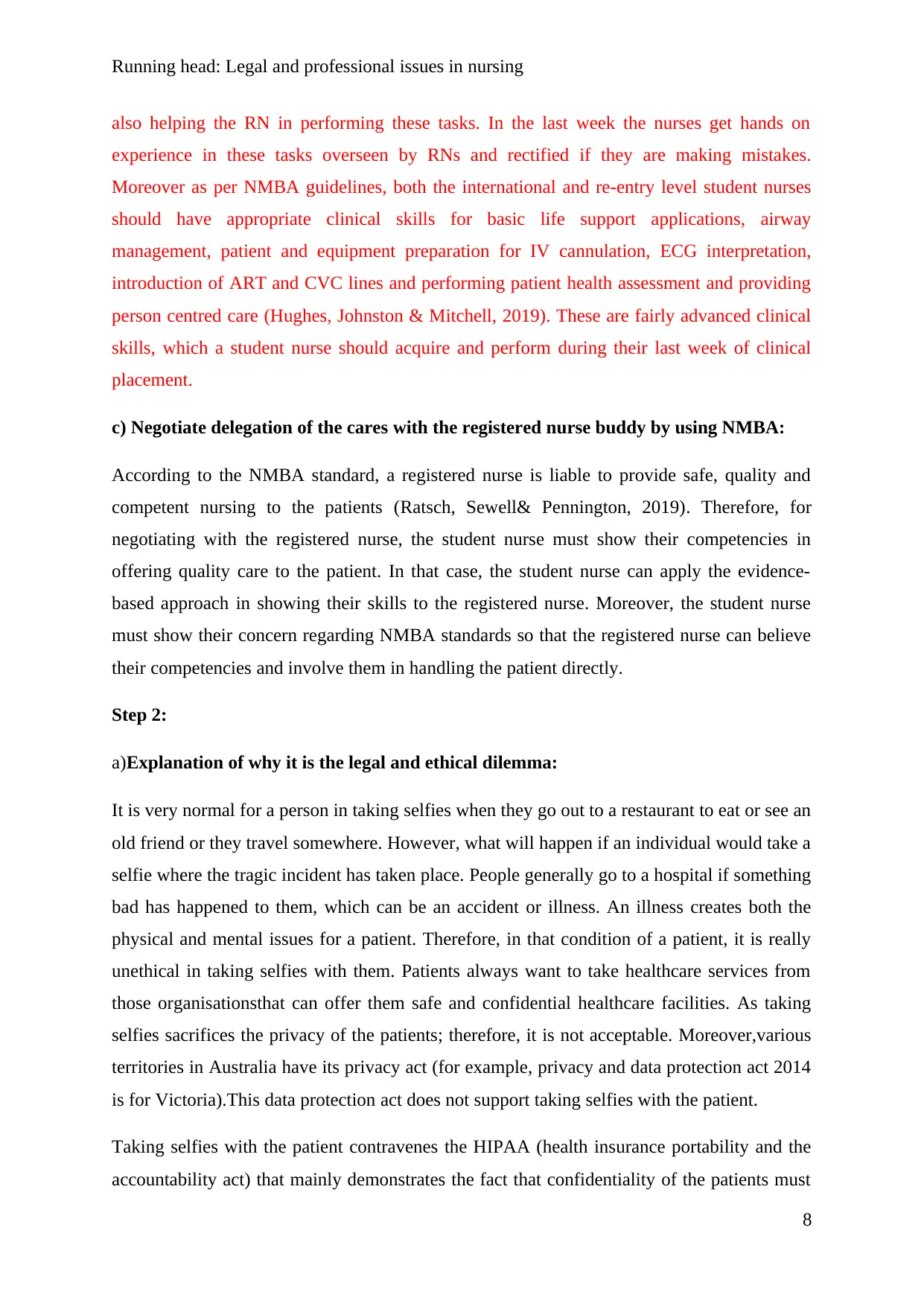
Running head: Legal and professional issues in nursing
also helping the RN in performing these tasks. In the last week the nurses get hands on
experience in these tasks overseen by RNs and rectified if they are making mistakes.
Moreover as per NMBA guidelines, both the international and re-entry level student nurses
should have appropriate clinical skills for basic life support applications, airway
management, patient and equipment preparation for IV cannulation, ECG interpretation,
introduction of ART and CVC lines and performing patient health assessment and providing
person centred care (Hughes, Johnston & Mitchell, 2019). These are fairly advanced clinical
skills, which a student nurse should acquire and perform during their last week of clinical
placement.
c) Negotiate delegation of the cares with the registered nurse buddy by using NMBA:
According to the NMBA standard, a registered nurse is liable to provide safe, quality and
competent nursing to the patients (Ratsch, Sewell& Pennington, 2019). Therefore, for
negotiating with the registered nurse, the student nurse must show their competencies in
offering quality care to the patient. In that case, the student nurse can apply the evidence-
based approach in showing their skills to the registered nurse. Moreover, the student nurse
must show their concern regarding NMBA standards so that the registered nurse can believe
their competencies and involve them in handling the patient directly.
Step 2:
a)Explanation of why it is the legal and ethical dilemma:
It is very normal for a person in taking selfies when they go out to a restaurant to eat or see an
old friend or they travel somewhere. However, what will happen if an individual would take a
selfie where the tragic incident has taken place. People generally go to a hospital if something
bad has happened to them, which can be an accident or illness. An illness creates both the
physical and mental issues for a patient. Therefore, in that condition of a patient, it is really
unethical in taking selfies with them. Patients always want to take healthcare services from
those organisationsthat can offer them safe and confidential healthcare facilities. As taking
selfies sacrifices the privacy of the patients; therefore, it is not acceptable. Moreover,various
territories in Australia have its privacy act (for example, privacy and data protection act 2014
is for Victoria).This data protection act does not support taking selfies with the patient.
Taking selfies with the patient contravenes the HIPAA (health insurance portability and the
accountability act) that mainly demonstrates the fact that confidentiality of the patients must
8
also helping the RN in performing these tasks. In the last week the nurses get hands on
experience in these tasks overseen by RNs and rectified if they are making mistakes.
Moreover as per NMBA guidelines, both the international and re-entry level student nurses
should have appropriate clinical skills for basic life support applications, airway
management, patient and equipment preparation for IV cannulation, ECG interpretation,
introduction of ART and CVC lines and performing patient health assessment and providing
person centred care (Hughes, Johnston & Mitchell, 2019). These are fairly advanced clinical
skills, which a student nurse should acquire and perform during their last week of clinical
placement.
c) Negotiate delegation of the cares with the registered nurse buddy by using NMBA:
According to the NMBA standard, a registered nurse is liable to provide safe, quality and
competent nursing to the patients (Ratsch, Sewell& Pennington, 2019). Therefore, for
negotiating with the registered nurse, the student nurse must show their competencies in
offering quality care to the patient. In that case, the student nurse can apply the evidence-
based approach in showing their skills to the registered nurse. Moreover, the student nurse
must show their concern regarding NMBA standards so that the registered nurse can believe
their competencies and involve them in handling the patient directly.
Step 2:
a)Explanation of why it is the legal and ethical dilemma:
It is very normal for a person in taking selfies when they go out to a restaurant to eat or see an
old friend or they travel somewhere. However, what will happen if an individual would take a
selfie where the tragic incident has taken place. People generally go to a hospital if something
bad has happened to them, which can be an accident or illness. An illness creates both the
physical and mental issues for a patient. Therefore, in that condition of a patient, it is really
unethical in taking selfies with them. Patients always want to take healthcare services from
those organisationsthat can offer them safe and confidential healthcare facilities. As taking
selfies sacrifices the privacy of the patients; therefore, it is not acceptable. Moreover,various
territories in Australia have its privacy act (for example, privacy and data protection act 2014
is for Victoria).This data protection act does not support taking selfies with the patient.
Taking selfies with the patient contravenes the HIPAA (health insurance portability and the
accountability act) that mainly demonstrates the fact that confidentiality of the patients must
8
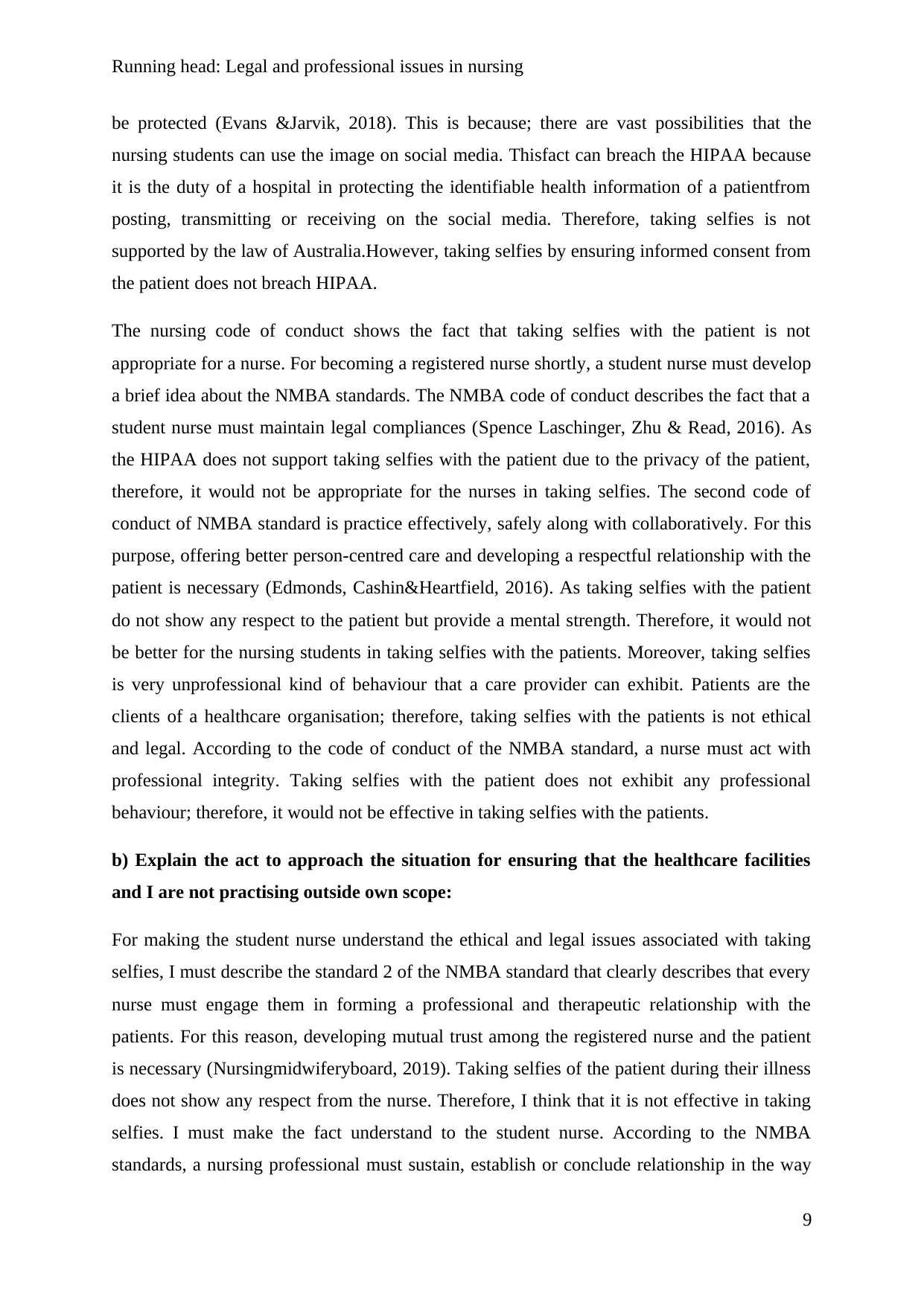
Running head: Legal and professional issues in nursing
be protected (Evans &Jarvik, 2018). This is because; there are vast possibilities that the
nursing students can use the image on social media. Thisfact can breach the HIPAA because
it is the duty of a hospital in protecting the identifiable health information of a patientfrom
posting, transmitting or receiving on the social media. Therefore, taking selfies is not
supported by the law of Australia.However, taking selfies by ensuring informed consent from
the patient does not breach HIPAA.
The nursing code of conduct shows the fact that taking selfies with the patient is not
appropriate for a nurse. For becoming a registered nurse shortly, a student nurse must develop
a brief idea about the NMBA standards. The NMBA code of conduct describes the fact that a
student nurse must maintain legal compliances (Spence Laschinger, Zhu & Read, 2016). As
the HIPAA does not support taking selfies with the patient due to the privacy of the patient,
therefore, it would not be appropriate for the nurses in taking selfies. The second code of
conduct of NMBA standard is practice effectively, safely along with collaboratively. For this
purpose, offering better person-centred care and developing a respectful relationship with the
patient is necessary (Edmonds, Cashin&Heartfield, 2016). As taking selfies with the patient
do not show any respect to the patient but provide a mental strength. Therefore, it would not
be better for the nursing students in taking selfies with the patients. Moreover, taking selfies
is very unprofessional kind of behaviour that a care provider can exhibit. Patients are the
clients of a healthcare organisation; therefore, taking selfies with the patients is not ethical
and legal. According to the code of conduct of the NMBA standard, a nurse must act with
professional integrity. Taking selfies with the patient does not exhibit any professional
behaviour; therefore, it would not be effective in taking selfies with the patients.
b) Explain the act to approach the situation for ensuring that the healthcare facilities
and I are not practising outside own scope:
For making the student nurse understand the ethical and legal issues associated with taking
selfies, I must describe the standard 2 of the NMBA standard that clearly describes that every
nurse must engage them in forming a professional and therapeutic relationship with the
patients. For this reason, developing mutual trust among the registered nurse and the patient
is necessary (Nursingmidwiferyboard, 2019). Taking selfies of the patient during their illness
does not show any respect from the nurse. Therefore, I think that it is not effective in taking
selfies. I must make the fact understand to the student nurse. According to the NMBA
standards, a nursing professional must sustain, establish or conclude relationship in the way
9
be protected (Evans &Jarvik, 2018). This is because; there are vast possibilities that the
nursing students can use the image on social media. Thisfact can breach the HIPAA because
it is the duty of a hospital in protecting the identifiable health information of a patientfrom
posting, transmitting or receiving on the social media. Therefore, taking selfies is not
supported by the law of Australia.However, taking selfies by ensuring informed consent from
the patient does not breach HIPAA.
The nursing code of conduct shows the fact that taking selfies with the patient is not
appropriate for a nurse. For becoming a registered nurse shortly, a student nurse must develop
a brief idea about the NMBA standards. The NMBA code of conduct describes the fact that a
student nurse must maintain legal compliances (Spence Laschinger, Zhu & Read, 2016). As
the HIPAA does not support taking selfies with the patient due to the privacy of the patient,
therefore, it would not be appropriate for the nurses in taking selfies. The second code of
conduct of NMBA standard is practice effectively, safely along with collaboratively. For this
purpose, offering better person-centred care and developing a respectful relationship with the
patient is necessary (Edmonds, Cashin&Heartfield, 2016). As taking selfies with the patient
do not show any respect to the patient but provide a mental strength. Therefore, it would not
be better for the nursing students in taking selfies with the patients. Moreover, taking selfies
is very unprofessional kind of behaviour that a care provider can exhibit. Patients are the
clients of a healthcare organisation; therefore, taking selfies with the patients is not ethical
and legal. According to the code of conduct of the NMBA standard, a nurse must act with
professional integrity. Taking selfies with the patient does not exhibit any professional
behaviour; therefore, it would not be effective in taking selfies with the patients.
b) Explain the act to approach the situation for ensuring that the healthcare facilities
and I are not practising outside own scope:
For making the student nurse understand the ethical and legal issues associated with taking
selfies, I must describe the standard 2 of the NMBA standard that clearly describes that every
nurse must engage them in forming a professional and therapeutic relationship with the
patients. For this reason, developing mutual trust among the registered nurse and the patient
is necessary (Nursingmidwiferyboard, 2019). Taking selfies of the patient during their illness
does not show any respect from the nurse. Therefore, I think that it is not effective in taking
selfies. I must make the fact understand to the student nurse. According to the NMBA
standards, a nursing professional must sustain, establish or conclude relationship in the way
9
⊘ This is a preview!⊘
Do you want full access?
Subscribe today to unlock all pages.

Trusted by 1+ million students worldwide
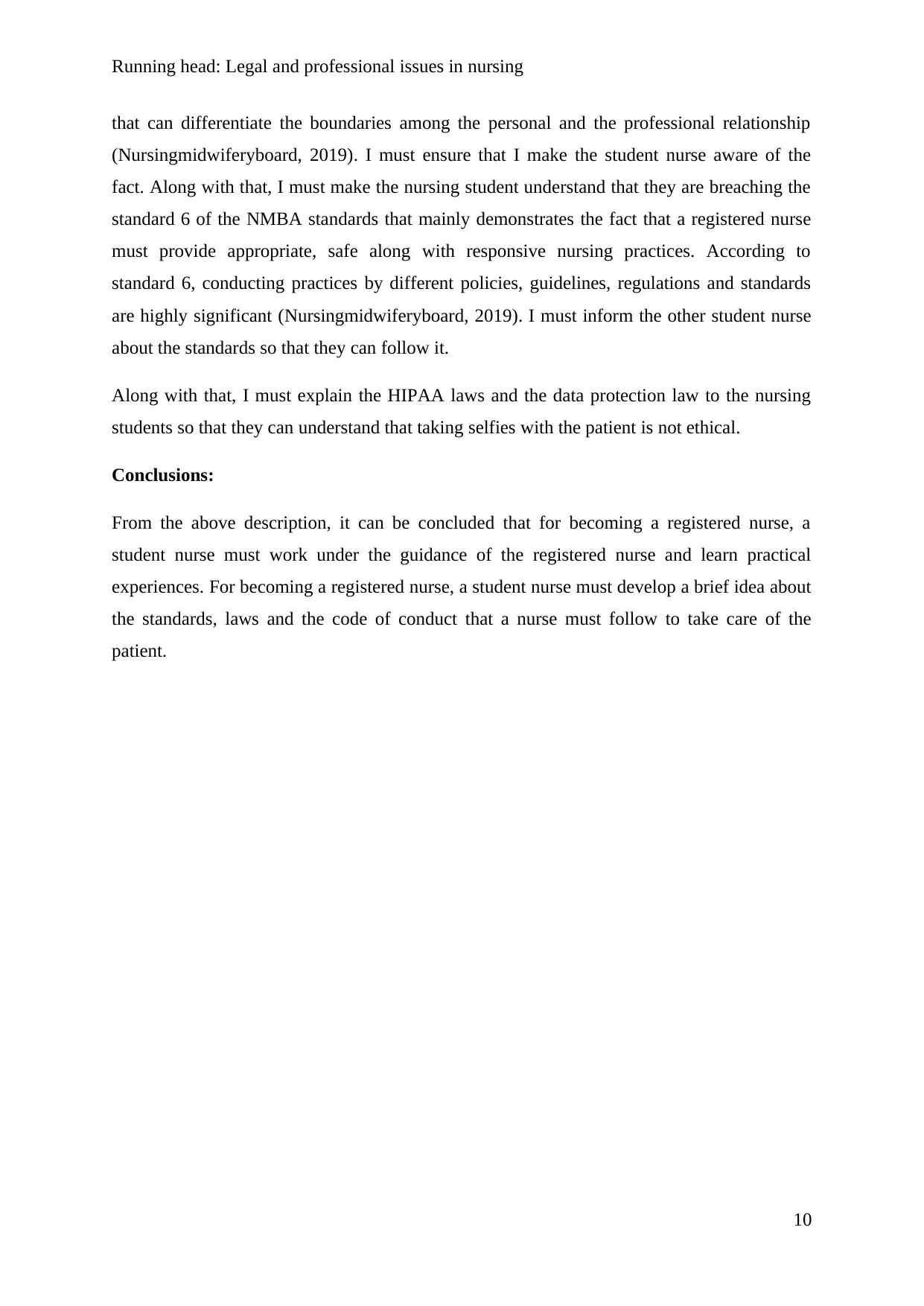
Running head: Legal and professional issues in nursing
that can differentiate the boundaries among the personal and the professional relationship
(Nursingmidwiferyboard, 2019). I must ensure that I make the student nurse aware of the
fact. Along with that, I must make the nursing student understand that they are breaching the
standard 6 of the NMBA standards that mainly demonstrates the fact that a registered nurse
must provide appropriate, safe along with responsive nursing practices. According to
standard 6, conducting practices by different policies, guidelines, regulations and standards
are highly significant (Nursingmidwiferyboard, 2019). I must inform the other student nurse
about the standards so that they can follow it.
Along with that, I must explain the HIPAA laws and the data protection law to the nursing
students so that they can understand that taking selfies with the patient is not ethical.
Conclusions:
From the above description, it can be concluded that for becoming a registered nurse, a
student nurse must work under the guidance of the registered nurse and learn practical
experiences. For becoming a registered nurse, a student nurse must develop a brief idea about
the standards, laws and the code of conduct that a nurse must follow to take care of the
patient.
10
that can differentiate the boundaries among the personal and the professional relationship
(Nursingmidwiferyboard, 2019). I must ensure that I make the student nurse aware of the
fact. Along with that, I must make the nursing student understand that they are breaching the
standard 6 of the NMBA standards that mainly demonstrates the fact that a registered nurse
must provide appropriate, safe along with responsive nursing practices. According to
standard 6, conducting practices by different policies, guidelines, regulations and standards
are highly significant (Nursingmidwiferyboard, 2019). I must inform the other student nurse
about the standards so that they can follow it.
Along with that, I must explain the HIPAA laws and the data protection law to the nursing
students so that they can understand that taking selfies with the patient is not ethical.
Conclusions:
From the above description, it can be concluded that for becoming a registered nurse, a
student nurse must work under the guidance of the registered nurse and learn practical
experiences. For becoming a registered nurse, a student nurse must develop a brief idea about
the standards, laws and the code of conduct that a nurse must follow to take care of the
patient.
10
Paraphrase This Document
Need a fresh take? Get an instant paraphrase of this document with our AI Paraphraser
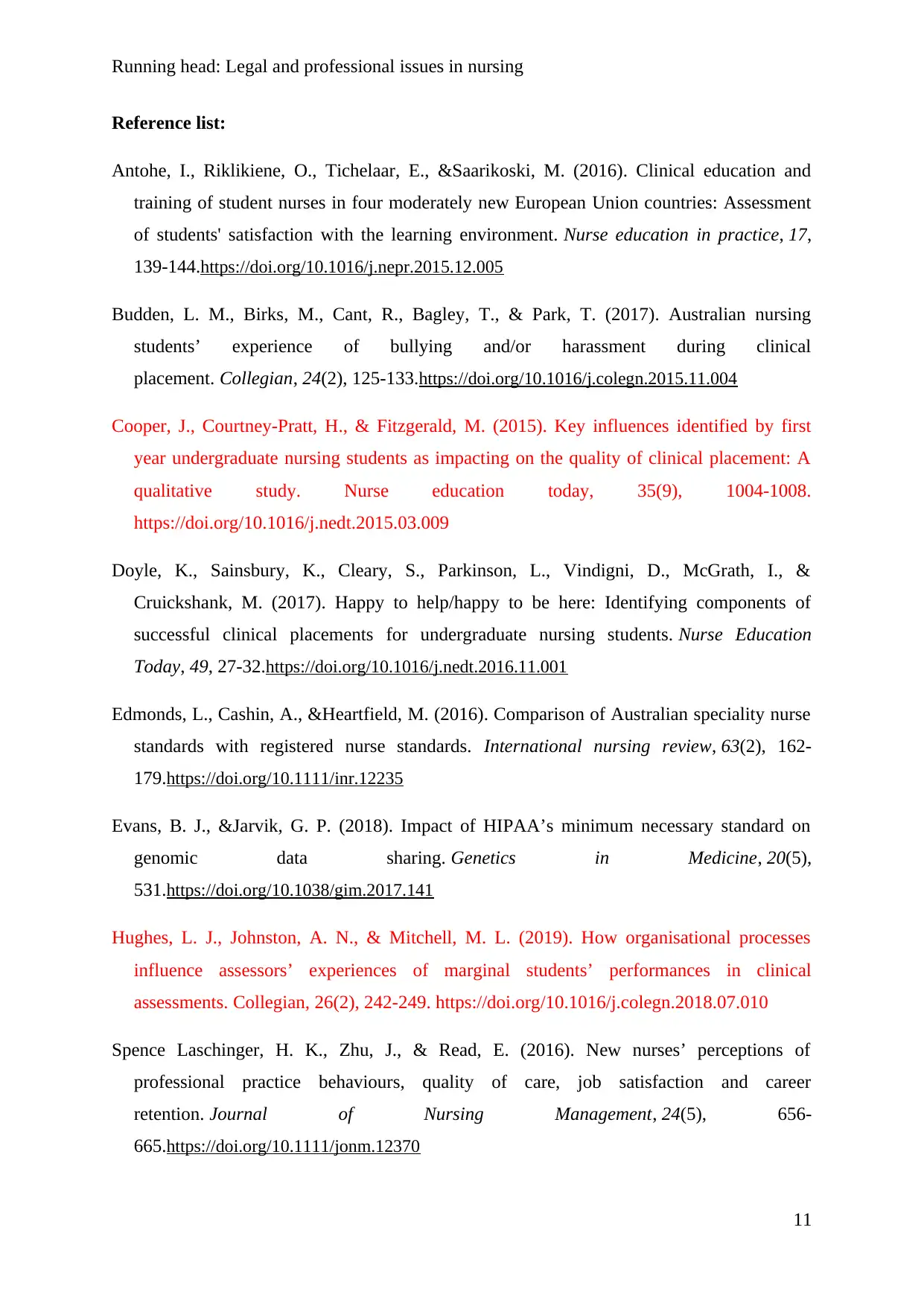
Running head: Legal and professional issues in nursing
Reference list:
Antohe, I., Riklikiene, O., Tichelaar, E., &Saarikoski, M. (2016). Clinical education and
training of student nurses in four moderately new European Union countries: Assessment
of students' satisfaction with the learning environment. Nurse education in practice, 17,
139-144.https://doi.org/10.1016/j.nepr.2015.12.005
Budden, L. M., Birks, M., Cant, R., Bagley, T., & Park, T. (2017). Australian nursing
students’ experience of bullying and/or harassment during clinical
placement. Collegian, 24(2), 125-133.https://doi.org/10.1016/j.colegn.2015.11.004
Cooper, J., Courtney-Pratt, H., & Fitzgerald, M. (2015). Key influences identified by first
year undergraduate nursing students as impacting on the quality of clinical placement: A
qualitative study. Nurse education today, 35(9), 1004-1008.
https://doi.org/10.1016/j.nedt.2015.03.009
Doyle, K., Sainsbury, K., Cleary, S., Parkinson, L., Vindigni, D., McGrath, I., &
Cruickshank, M. (2017). Happy to help/happy to be here: Identifying components of
successful clinical placements for undergraduate nursing students. Nurse Education
Today, 49, 27-32.https://doi.org/10.1016/j.nedt.2016.11.001
Edmonds, L., Cashin, A., &Heartfield, M. (2016). Comparison of Australian speciality nurse
standards with registered nurse standards. International nursing review, 63(2), 162-
179.https://doi.org/10.1111/inr.12235
Evans, B. J., &Jarvik, G. P. (2018). Impact of HIPAA’s minimum necessary standard on
genomic data sharing. Genetics in Medicine, 20(5),
531.https://doi.org/10.1038/gim.2017.141
Hughes, L. J., Johnston, A. N., & Mitchell, M. L. (2019). How organisational processes
influence assessors’ experiences of marginal students’ performances in clinical
assessments. Collegian, 26(2), 242-249. https://doi.org/10.1016/j.colegn.2018.07.010
Spence Laschinger, H. K., Zhu, J., & Read, E. (2016). New nurses’ perceptions of
professional practice behaviours, quality of care, job satisfaction and career
retention. Journal of Nursing Management, 24(5), 656-
665.https://doi.org/10.1111/jonm.12370
11
Reference list:
Antohe, I., Riklikiene, O., Tichelaar, E., &Saarikoski, M. (2016). Clinical education and
training of student nurses in four moderately new European Union countries: Assessment
of students' satisfaction with the learning environment. Nurse education in practice, 17,
139-144.https://doi.org/10.1016/j.nepr.2015.12.005
Budden, L. M., Birks, M., Cant, R., Bagley, T., & Park, T. (2017). Australian nursing
students’ experience of bullying and/or harassment during clinical
placement. Collegian, 24(2), 125-133.https://doi.org/10.1016/j.colegn.2015.11.004
Cooper, J., Courtney-Pratt, H., & Fitzgerald, M. (2015). Key influences identified by first
year undergraduate nursing students as impacting on the quality of clinical placement: A
qualitative study. Nurse education today, 35(9), 1004-1008.
https://doi.org/10.1016/j.nedt.2015.03.009
Doyle, K., Sainsbury, K., Cleary, S., Parkinson, L., Vindigni, D., McGrath, I., &
Cruickshank, M. (2017). Happy to help/happy to be here: Identifying components of
successful clinical placements for undergraduate nursing students. Nurse Education
Today, 49, 27-32.https://doi.org/10.1016/j.nedt.2016.11.001
Edmonds, L., Cashin, A., &Heartfield, M. (2016). Comparison of Australian speciality nurse
standards with registered nurse standards. International nursing review, 63(2), 162-
179.https://doi.org/10.1111/inr.12235
Evans, B. J., &Jarvik, G. P. (2018). Impact of HIPAA’s minimum necessary standard on
genomic data sharing. Genetics in Medicine, 20(5),
531.https://doi.org/10.1038/gim.2017.141
Hughes, L. J., Johnston, A. N., & Mitchell, M. L. (2019). How organisational processes
influence assessors’ experiences of marginal students’ performances in clinical
assessments. Collegian, 26(2), 242-249. https://doi.org/10.1016/j.colegn.2018.07.010
Spence Laschinger, H. K., Zhu, J., & Read, E. (2016). New nurses’ perceptions of
professional practice behaviours, quality of care, job satisfaction and career
retention. Journal of Nursing Management, 24(5), 656-
665.https://doi.org/10.1111/jonm.12370
11
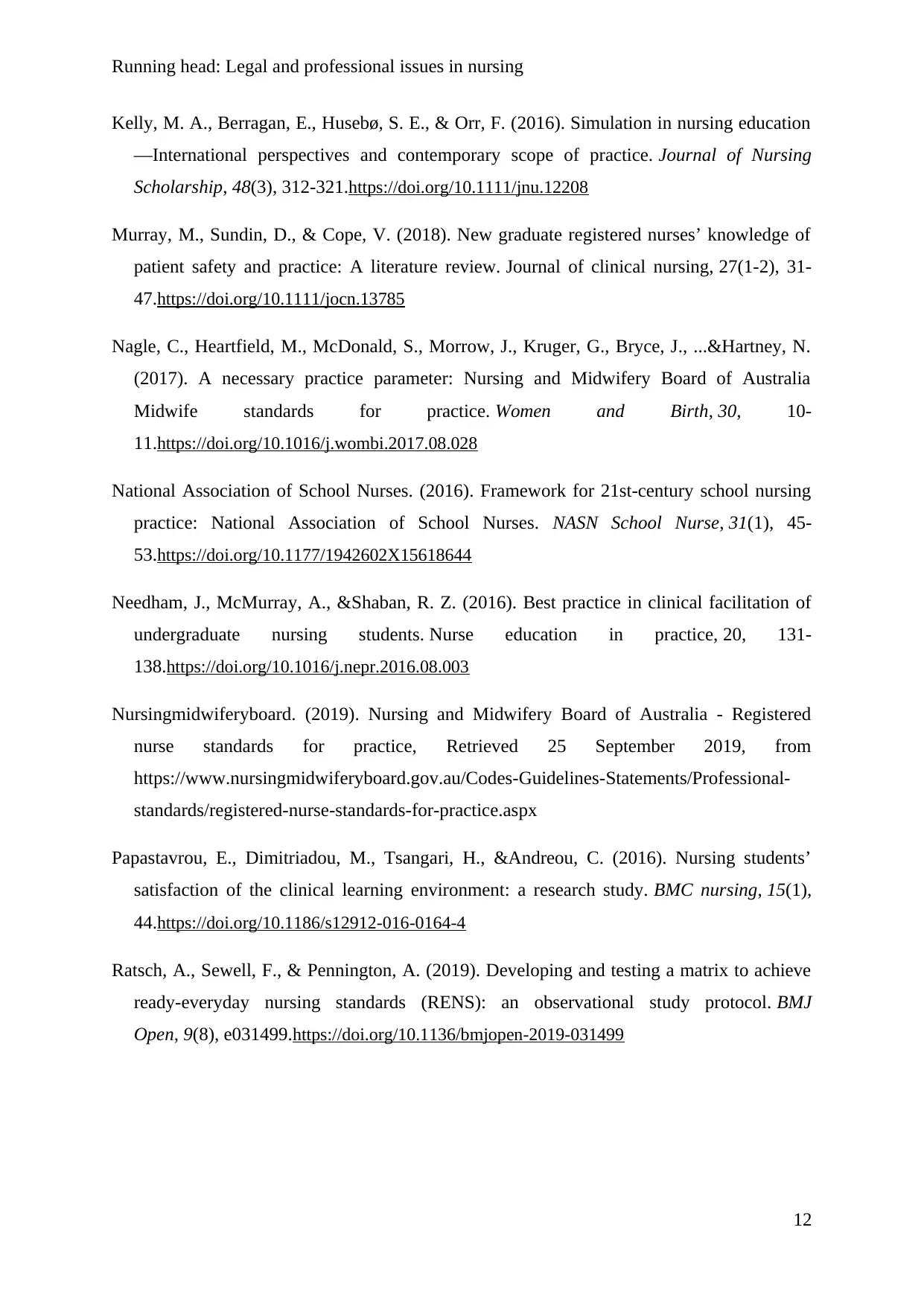
Running head: Legal and professional issues in nursing
Kelly, M. A., Berragan, E., Husebø, S. E., & Orr, F. (2016). Simulation in nursing education
—International perspectives and contemporary scope of practice. Journal of Nursing
Scholarship, 48(3), 312-321.https://doi.org/10.1111/jnu.12208
Murray, M., Sundin, D., & Cope, V. (2018). New graduate registered nurses’ knowledge of
patient safety and practice: A literature review. Journal of clinical nursing, 27(1-2), 31-
47.https://doi.org/10.1111/jocn.13785
Nagle, C., Heartfield, M., McDonald, S., Morrow, J., Kruger, G., Bryce, J., ...&Hartney, N.
(2017). A necessary practice parameter: Nursing and Midwifery Board of Australia
Midwife standards for practice. Women and Birth, 30, 10-
11.https://doi.org/10.1016/j.wombi.2017.08.028
National Association of School Nurses. (2016). Framework for 21st-century school nursing
practice: National Association of School Nurses. NASN School Nurse, 31(1), 45-
53.https://doi.org/10.1177/1942602X15618644
Needham, J., McMurray, A., &Shaban, R. Z. (2016). Best practice in clinical facilitation of
undergraduate nursing students. Nurse education in practice, 20, 131-
138.https://doi.org/10.1016/j.nepr.2016.08.003
Nursingmidwiferyboard. (2019). Nursing and Midwifery Board of Australia - Registered
nurse standards for practice, Retrieved 25 September 2019, from
https://www.nursingmidwiferyboard.gov.au/Codes-Guidelines-Statements/Professional-
standards/registered-nurse-standards-for-practice.aspx
Papastavrou, E., Dimitriadou, M., Tsangari, H., &Andreou, C. (2016). Nursing students’
satisfaction of the clinical learning environment: a research study. BMC nursing, 15(1),
44.https://doi.org/10.1186/s12912-016-0164-4
Ratsch, A., Sewell, F., & Pennington, A. (2019). Developing and testing a matrix to achieve
ready-everyday nursing standards (RENS): an observational study protocol. BMJ
Open, 9(8), e031499.https://doi.org/10.1136/bmjopen-2019-031499
12
Kelly, M. A., Berragan, E., Husebø, S. E., & Orr, F. (2016). Simulation in nursing education
—International perspectives and contemporary scope of practice. Journal of Nursing
Scholarship, 48(3), 312-321.https://doi.org/10.1111/jnu.12208
Murray, M., Sundin, D., & Cope, V. (2018). New graduate registered nurses’ knowledge of
patient safety and practice: A literature review. Journal of clinical nursing, 27(1-2), 31-
47.https://doi.org/10.1111/jocn.13785
Nagle, C., Heartfield, M., McDonald, S., Morrow, J., Kruger, G., Bryce, J., ...&Hartney, N.
(2017). A necessary practice parameter: Nursing and Midwifery Board of Australia
Midwife standards for practice. Women and Birth, 30, 10-
11.https://doi.org/10.1016/j.wombi.2017.08.028
National Association of School Nurses. (2016). Framework for 21st-century school nursing
practice: National Association of School Nurses. NASN School Nurse, 31(1), 45-
53.https://doi.org/10.1177/1942602X15618644
Needham, J., McMurray, A., &Shaban, R. Z. (2016). Best practice in clinical facilitation of
undergraduate nursing students. Nurse education in practice, 20, 131-
138.https://doi.org/10.1016/j.nepr.2016.08.003
Nursingmidwiferyboard. (2019). Nursing and Midwifery Board of Australia - Registered
nurse standards for practice, Retrieved 25 September 2019, from
https://www.nursingmidwiferyboard.gov.au/Codes-Guidelines-Statements/Professional-
standards/registered-nurse-standards-for-practice.aspx
Papastavrou, E., Dimitriadou, M., Tsangari, H., &Andreou, C. (2016). Nursing students’
satisfaction of the clinical learning environment: a research study. BMC nursing, 15(1),
44.https://doi.org/10.1186/s12912-016-0164-4
Ratsch, A., Sewell, F., & Pennington, A. (2019). Developing and testing a matrix to achieve
ready-everyday nursing standards (RENS): an observational study protocol. BMJ
Open, 9(8), e031499.https://doi.org/10.1136/bmjopen-2019-031499
12
⊘ This is a preview!⊘
Do you want full access?
Subscribe today to unlock all pages.

Trusted by 1+ million students worldwide
1 out of 12
Related Documents
Your All-in-One AI-Powered Toolkit for Academic Success.
+13062052269
info@desklib.com
Available 24*7 on WhatsApp / Email
![[object Object]](/_next/static/media/star-bottom.7253800d.svg)
Unlock your academic potential
Copyright © 2020–2025 A2Z Services. All Rights Reserved. Developed and managed by ZUCOL.





